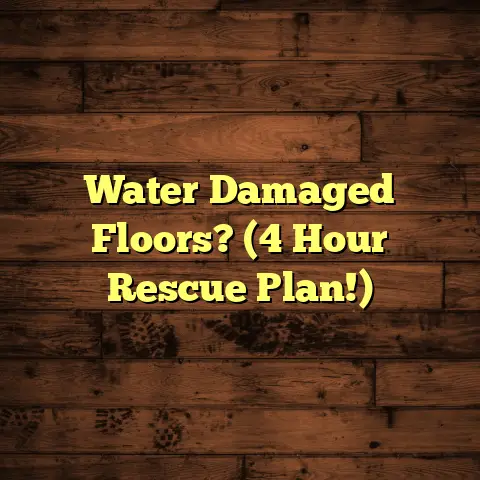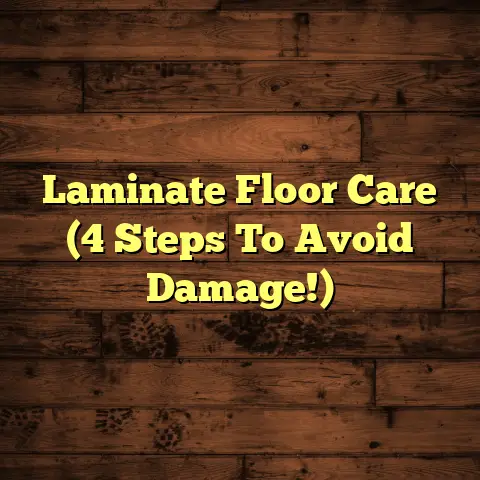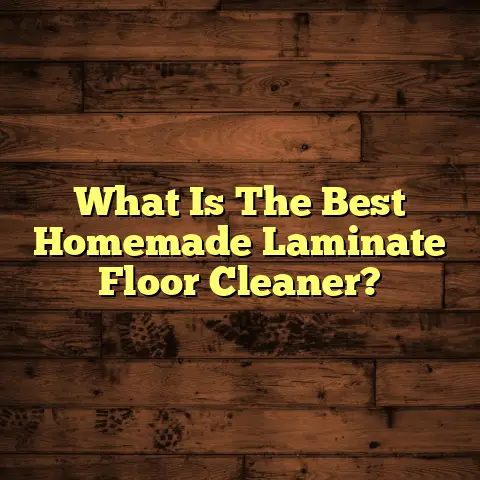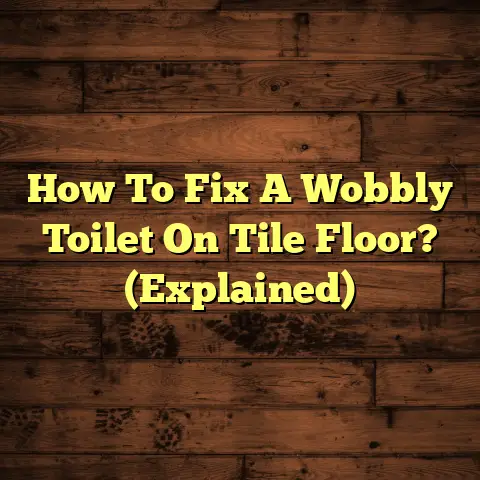Do Quarry Tiles Need Sealer? (1 Crucial Sealing Step!)
Have you ever stopped to really look at your quarry tile floor?
I mean, really look?
Have you wondered if those beautiful, earthy-toned tiles are truly safe from spills, grime, and the daily wear and tear of life?
Or are they silently soaking up everything you drop, slowly losing their luster?
As a flooring contractor with over 15 years in the game, I can tell you firsthand: sealing quarry tile is not optional.
It’s essential.
Let’s dive deep into why, and I’ll share that one crucial sealing step that makes all the difference.
Section 1: Understanding Quarry Tiles
1. Definition and Characteristics
So, what exactly are quarry tiles?
They’re not actually from a quarry in the traditional sense.
Unlike natural stone tiles like granite or marble, quarry tiles are made from a mix of clay, shale, and sometimes other natural materials.
These materials are ground, mixed with water, formed (usually by extrusion), and then fired at incredibly high temperatures.
This firing process gives them their characteristic density, durability, and slightly rustic appearance.
Think of them as the workhorses of the tile world.
They’re tough, resistant to water, and come in a range of earthy colors like reds, browns, and grays.
You’ll often find them in high-traffic areas like kitchens, hallways, and even commercial spaces.
What makes them so appealing?
- Durability: They can withstand a lot of abuse.
- Natural Beauty: That earthy tone adds warmth.
- Versatility: They work in modern and rustic designs.
- Slip Resistance: Many have a naturally textured surface.
But that texture?
That’s where the sealing question comes in.
2. Historical Context
Quarry tiles have been around for a long time.
They’ve been used for centuries in both residential and commercial settings.
Originally, they were prized for their ability to withstand heavy foot traffic and harsh conditions.
Think industrial kitchens, breweries, and even barn floors!
Their inherent durability made them a practical choice.
Over time, people began to appreciate their aesthetic appeal.
The warm, natural colors and slightly irregular shapes added character to any space.
Now, you’ll find them in everything from modern farmhouses to trendy restaurants.
Their popularity has evolved, but their core appeal remains the same: tough, beautiful, and versatile.
Section 2: The Importance of Sealing
1. Understanding Sealing
Okay, let’s get down to brass tacks.
What does “sealing” actually mean when we’re talking about flooring?
Essentially, it’s the process of applying a protective coating to the surface of the tile.
This coating acts as a barrier, preventing liquids, dirt, and other contaminants from penetrating the tile’s pores.
Think of it like applying a raincoat to your floor.
The sealer fills in those microscopic pores and creates a smooth, impermeable surface.
This makes the tile easier to clean, more resistant to stains, and less susceptible to damage.
Without a sealer, quarry tiles are like sponges.
They’ll soak up anything you spill on them, leaving behind unsightly stains and potentially causing long-term damage.
2. Potential Issues Without Sealing
So, what happens if you skip the sealing step?
Let me tell you, I’ve seen the consequences firsthand.
Here’s a breakdown of the problems you might encounter with unsealed quarry tiles:
- Staining: This is the most obvious issue. Coffee, wine, grease – they all seep into the porous surface, leaving permanent marks.
- Moisture Absorption: Quarry tiles, while durable, are still porous. Without a sealer, they can absorb moisture, leading to mold and mildew growth, especially in damp environments like bathrooms or kitchens.
- Efflorescence: This is a white, powdery deposit that can appear on the surface of the tile. It’s caused by salts and minerals being drawn to the surface by moisture. It’s unsightly and can damage the tile over time.
- Cracking and Spalling: In freezing climates, absorbed water can freeze and expand, causing the tile to crack or even break apart (spalling).
- Increased Cleaning Effort: Unsealed tiles are much harder to clean. Dirt and grime get trapped in the pores, requiring more aggressive cleaning methods.
I remember one client in particular.
They had a beautiful quarry tile floor in their kitchen, but they had never sealed it.
Over the years, it had become stained with everything from tomato sauce to cooking oil.
The grout was discolored and crumbling.
The cost to professionally clean and then seal the floor was almost as much as it would have cost to install a new floor in the first place!
That’s a lesson I’ve shared with countless homeowners since then.
Sealing is a relatively inexpensive process that can save you a lot of money and headaches down the road.
Section 3: Benefits of Sealing Quarry Tiles
Okay, so we know what not sealing can do.
Let’s flip the script and talk about the benefits of taking that extra step.
1. Protection Against Stains
This is the big one.
A good sealer will create a barrier that prevents stains from penetrating the tile.
Think of it like this: instead of soaking into the tile, spills will simply sit on the surface, allowing you to wipe them away with ease.
I’ve seen sealers repel everything from red wine to turmeric, leaving the tile looking as good as new.
It’s like having a superpower against everyday messes.
2. Moisture Resistance
As I mentioned earlier, quarry tiles are porous.
This means they can absorb moisture, which can lead to a whole host of problems.
A sealer will help to repel water, preventing it from seeping into the tile and causing mold, mildew, or efflorescence.
This is especially important in areas that are prone to moisture, like bathrooms, kitchens, and entryways.
Think of it as an invisible shield against water damage.
3. Ease of Maintenance
Sealed quarry tiles are much easier to clean than unsealed ones.
Because the sealer creates a smooth, impermeable surface, dirt and grime can’t get trapped in the pores.
This means you can clean your floors with a simple mop and a mild detergent.
No more scrubbing for hours to remove stubborn stains!
I always tell my clients that sealing is an investment in their time and energy.
It reduces the amount of effort required to keep their floors looking their best.
4. Enhanced Longevity
Ultimately, sealing your quarry tiles will extend their lifespan.
By protecting them from stains, moisture, and other damage, you’re helping them to stay in good condition for longer.
This means you won’t have to replace them as often, saving you money in the long run.
Think of it as preventative maintenance for your floors.
A little bit of effort upfront can pay off big time down the road.
According to the National Tile Contractors Association (NTCA), proper sealing and maintenance can extend the life of a tile floor by 10-20 years.
That’s a significant return on investment!
Section 4: The Sealing Process
Alright, you’re convinced. Sealing is a must.
But how do you actually do it?
Let’s break down the process step-by-step.
1. Choosing the Right Sealer
This is a crucial step.
Not all sealers are created equal.
There are two main types of sealers for quarry tiles:
- Penetrating Sealers: These sealers penetrate the surface of the tile and create a barrier from within. They don’t change the appearance of the tile and are ideal for maintaining a natural look. They’re great for stain protection.
- Topical Sealers: These sealers create a coating on the surface of the tile. They can provide a higher level of protection, but they can also alter the appearance of the tile, adding a sheen or gloss. They’re good for moisture resistance.
When choosing a sealer, consider the following factors:
- Type of Tile: Some sealers are specifically designed for certain types of tile. Make sure you choose one that’s compatible with quarry tile.
- Desired Appearance: Do you want to maintain the natural look of the tile, or are you okay with adding a sheen?
- Level of Protection: How much protection do you need? If you’re dealing with a high-traffic area or a lot of spills, you’ll want a more robust sealer.
- Water-Based vs. Solvent-Based: Water-based sealers are generally easier to apply and clean up, while solvent-based sealers offer better protection.
I personally prefer penetrating sealers for quarry tile.
They maintain the natural look and feel of the tile while providing excellent stain protection.
Plus, they’re easier to apply and less likely to yellow or peel over time.
2. Preparing the Surface
Before you can apply the sealer, you need to make sure the surface is clean and dry.
Here’s how to prepare your quarry tiles for sealing:
- Clean the Floor: Use a mild detergent and water to remove any dirt, grime, or stains. Rinse thoroughly with clean water.
- Remove Old Sealers (If Necessary): If your tiles have been previously sealed, you may need to remove the old sealer before applying a new one. Use a sealer stripper according to the manufacturer’s instructions.
- Allow the Floor to Dry Completely: This is crucial. The sealer won’t adhere properly to a damp surface. Allow the floor to dry for at least 24 hours, or longer if necessary.
I can’t stress enough how important it is to have a completely clean and dry surface before sealing.
Any dirt or moisture trapped beneath the sealer will compromise its effectiveness.
3. Application Techniques
There are several ways to apply sealer to quarry tiles:
- Brush: A brush is good for applying sealer to grout lines and edges.
- Roller: A roller is ideal for covering large areas quickly and evenly.
- Sprayer: A sprayer can be used to apply a thin, even coat of sealer.
No matter which method you choose, be sure to follow the manufacturer’s instructions carefully.
Here are some best practices for applying sealer:
- Apply Thin, Even Coats: Avoid applying too much sealer at once, as this can lead to drips and uneven coverage.
- Work in Small Sections: This will help you to ensure that you’re applying the sealer evenly.
- Overlap Your Strokes: This will prevent gaps in coverage.
- Wipe Away Excess Sealer: Use a clean cloth to wipe away any excess sealer that doesn’t penetrate the tile.
- Ventilate the Area: Sealers can release fumes, so be sure to ventilate the area well while you’re working.
I usually recommend applying two thin coats of sealer, allowing each coat to dry completely before applying the next.
This will provide a more durable and effective barrier.
4. Curing and Maintenance
Once you’ve applied the sealer, you need to allow it to cure properly.
This typically takes 24-72 hours, depending on the type of sealer you’re using.
During the curing process, avoid walking on the floor or getting it wet.
After the sealer has cured, you can start to maintain your quarry tile floor by:
- Sweeping or Vacuuming Regularly: This will remove any dirt or debris that could scratch the surface of the sealer.
- Mopping with a Mild Detergent: Use a pH-neutral cleaner to avoid damaging the sealer.
- Reapplying Sealer as Needed: Depending on the amount of traffic your floor receives, you may need to reapply sealer every 1-3 years.
I always tell my clients to think of sealing as an ongoing process, not a one-time event.
Regular maintenance and reapplication will help to keep their floors looking their best for years to come.
Section 5: Common Myths and Misconceptions
Let’s bust some myths!
There are a lot of misconceptions out there about quarry tiles and sealing.
1. Myth-Busting
- Myth: Quarry tiles don’t need to be sealed.
- Reality: As we’ve discussed, quarry tiles are porous and will benefit from sealing.
- Myth: Sealing will change the appearance of the tile.
- Reality: Penetrating sealers won’t change the appearance of the tile. Topical sealers may add a sheen or gloss.
- Myth: Sealing is too difficult to do myself.
- Reality: Sealing is a relatively simple process that most homeowners can do themselves.
- Myth: Once you seal quarry tiles, you never have to do it again.
- Reality: Sealer wears down over time and needs to be reapplied periodically.
2. Expert Opinions
I’m not the only one who believes in the importance of sealing quarry tiles.
Here’s what some other experts have to say:
- “Sealing quarry tile is essential to protect it from stains and moisture damage.” – Tile Magazine
- “A good sealer will extend the life of your quarry tile floor and make it easier to maintain.” – The Spruce
- “Don’t skip the sealing step! It’s the best way to keep your quarry tiles looking their best.” – Bob Vila
Section 6: Conclusion
So, do quarry tiles need sealer?
The answer is a resounding yes!
Sealing quarry tiles is a crucial step in preserving their beauty, functionality, and longevity.
It protects them from stains, moisture, and other damage, making them easier to clean and maintain.
By taking the time to seal your quarry tiles, you’re investing in their future and ensuring that they’ll continue to look their best for years to come.
Remember that one crucial sealing step?
It’s preparation.
Thorough cleaning and complete drying are the keys to a successful sealing job.
Don’t skip this step!
Now, I want you to take a good, hard look at your own quarry tile floor.
Is it sealed?
If not, now’s the time to take action.
Call to Action
Assess your quarry tile flooring today.
Is it looking dull, stained, or damaged?
Consider the sealing process to ensure your investment remains protected and beautiful for years to come.
Your floors will thank you for it!





